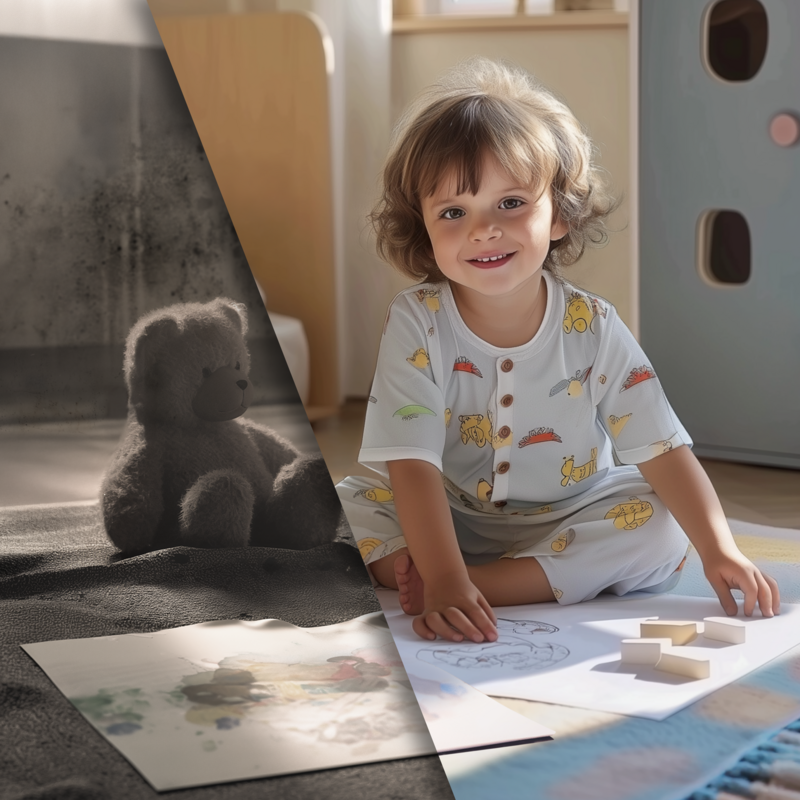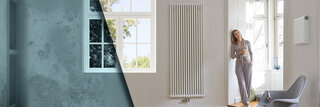
Don’t do it by halves!
Effective mould prevention: Zehnder systems help reduce troublesome mould from forming in houses and apartment buildings.
Bad air and a bad feeling: more than 80 million people in Europe live in homes that are too damp. Often, the cause is old, poorly maintained building structures — or modern renovations that haven’t been planned holistically. In many cases, new thermal insulation significantly reduces air exchange, leading to deteriorated indoor air quality. One in five European households is affected by mould.
Mould is usually only discovered once spores become visible — which is far too late. By then, health risks and costly repairs may already be unavoidable. That’s why, when it comes to mould, we don’t take any chances.
Over 12 liters are produced ...
A family of four produces 12 litres of moisture every day — just by breathing, cooking and showering. Without proper ventilation, this moisture stays trapped indoors.

Over 70 percent ...
humidity contributes to ideal conditions for mould to form.

At least 20 percent ...
of households in Europe have problems with mould.



Mould is caused gradually by moisture. It is often the result of insufficient ventilation and heating – closed rooms with no air circulation are particularly susceptible to mould. Some of the moisture is produced by people themselves – through activities such as cooking, showering, sweating and breathing. Moisture is even generated when no one is at home, for example through houseplants releasing moisture into the air.

The presence of mould often means that renovation is necessary. Determine your renovation needs and find out what measures have an impact on humidity in the home.
... not renovated.
Be warned: high risk of mould! Poorly sealed windows, uninsulated walls and undiscovered mould can have an influence on air quality and your health. The lack of insulation also increases your energy consumption.
Measure the humidity and seek advice from an expert on what steps to take.

... insulated.
A good start but still no guarantee of a mould-free environment. On the contrary, the quality of air in newly insulated rooms or well-insulated new buildings is often poor because the air is unable to circulate properly. Frequent ventilation can stop mould from forming but this also leads to a loss of energy and heat.
A professional ventilation system ensures optimum air circulation while reducing energy costs.

... insulated and ventilated?
If your property has already been renovated extensively, with both insulation and a ventilation system, you can breathe easy. The air quality should be noticeably better and the risk of mould is virtually zero.
With heat recovery and an air-temperation system, you not only cut down on energy consumption but also make massive savings on costs. In many cases, Zehnder systems that are already in place can be upgraded very easily.

... renovated completely?
The best of all worlds! Your property is insulated and has an advanced heating and ventilation system with heat recovery – meaning that your rooms are supplied with plenty of fresh air. Mould has no chance of forming here. Our advice: Depending on the type of system, there may even be further potential for saving on energy costs. Our Zehnder experts will be happy to recommend the best solution for you.

More efficiency
Good news for the environment and for your wallet: our heating and ventilation systems actively prevent mould by allowing air to circulate and and avoiding moisture, therefore keeping energy consumption to a minimum.
More comfort
Our solutions create a perfect indoor climate that prevents the growth of mould spores. Clear air for a healthy and comfortable home.
More flexibility
Whether a small room or a large apartment complex, installing a new system or retrofitting an existing one: our technology is suitable for any type of home or building – and already protects thousands of buildings around the world from mould formation.
Better health
Our products reduce moisture and harmful substances from the air or prevent them from forming in the first place. This keeps mould at bay – allowing you to relax and breathe easy.
Less moisture. Lower risk. Healthier home.
Our solution for moisture problems is efficient ventilation with heat recovery. Zehnder ventilation systems remove excess moisture from the air before this can lead to mould. At the same time, the intelligent air flow technology prevents condensation from forming, at any time of year.
Create a healthy indoor air climate with optimal air circulation: Our heating systems are a particularly effective addition to state-of-the-art heat pumps. This means that you can say goodbye to cold rooms and hello to a comfortable indoor climate.
Mould is a member of the fungus family and is a natural part of our lives. The tiny organisms help to decompose organic material in the environment. In our homes, the fungi release microscopically small spores that eventually become visible to the naked eye – especially on walls, on window frames or in joints.
All types of mould love moisture. This means that the organisms form above all in places where it is wet or where humidity exceeds certain levels, generally when it is constantly more than 70 percent. Incorrect thermal insulation and the airtightness resulting from highly effective insulation are both factors that influence humidity. This is why it is especially important to have sufficient air circulation.
Humidity in the home should be between 40-60%. Anything above or below this can be bad for the basic structure of the building and can also impact the health of the people living there.
In theory, mould can form in any room of a house or apartment. All that is needed is a high level of moisture or humidity over a longer period of time. But in practice, mould frequently forms in bathrooms, kitchens or bedrooms. Activities such as cooking, showering and even breathing all release water vapour – an ideal breeding ground for mould.
For the basic structure of the building, mould is first and foremost an indicator that moisture levels are too high. In the long term, this has a negative impact, so it is particularly important to get to the root of the problem. Leakages and thermal bridges must be dealt with quickly. Poor air circulation can be rectified through ventilation systems. By contrast, mould is hazardous to human health. Apart from possible unpleasant odours, it can lead to respiratory illnesses, skin disorders and problems with the nasal mucous membranes.
If mould is caused by construction errors – for example a window not being sealed properly – you should enlist the help of skilled professionals. Should you fail to do so, it is possible that the basic structure of the building will suffer serious shortcomings in the long term. If the mould formation is due to poor air circulation, this can be resolved simply by ventilating the room. Even a few minutes of quick, intensive ventilation – for example after a hot shower – can make a difference. Other tips include not drying laundry indoors, switching on the extractor hood when cooking and making use of dehumidifiers. A humidity sensor or hygrometer can also help you keep track of humidity levels in your home.
A ventilation system is the best way to create an environment where mould cannot grow. These systems have integrated sensors that detect when humidity is too high and switch on automatically. In this way, the air in the room in question can circulate, creating a perfect indoor climate where mould has a reduced chance of forming. Our experts can help you to find the most suitable ventilation system for your house or apartment. Contact us now!
General Request
Contact FormOffer Request
Contact FormOrder Request
Contact FormGeneral Request
+44 (0) 1276 605 800Technical Support
+44 (0) 1276 605 800